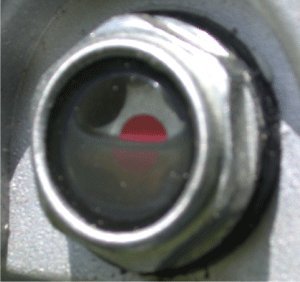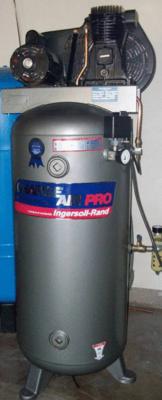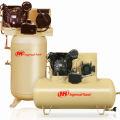Hey! This site is reader-supported and we earn commissions if you purchase products from retailers after clicking on a link from our site.
It can be quite a daunting task trying to figure out how to change your air compressor oil, how much to use and what the correct oil to use is right? Well, fear no more, I will answer all these questions in relation to Ingersoll Rand compressor oil for you.
Table of Contents
- What kind of Oil goes in a Ingersoll Rand Compressor?
- How much Oil to use in a Ingersoll Rand Compressor?
- How to change Ingersoll Rand Compressor Oil
- Ingersoll Rand Compressor Oil FAQs (Frequently Asked Questions)
What kind of Oil goes in a Ingersoll Rand Compressor?
It is extremely important to refer to your compressor manual before purchasing oil for your Ingersoll Rand The manual will tell you what oil is compatible with your air compressor, if you cannot locate your manual, please contact Ingersoll Rand directly or visit their website to download a manual for your compressor.
Ingersoll Rand Compressor Oils on Amazon
Ingersoll Rand offer high-quality compressor oil that can help keep your Ingersoll Rand compressor running smoothly. I have picked out a few Ingersoll Rand oils readily available on Amazon that could match your requirements.
The first is the Ingersoll Rand 38440236 below, this is a synthetic all-temperature blend that is designed to maintain optimal performance of any reciprocating compressor.
- All Season Select lubricant is a synthetic, all-temperature blend designed to maintain optimal performance of any reciprocating compressor
Prices pulled from the Amazon Product Advertising API on:
Product prices and availability are accurate as of the date/time indicated and are subject to change. Any price and availability information displayed on [relevant Amazon Site(s), as applicable] at the time of purchase will apply to the purchase of this product.
The other is the Ingersoll Rand Ultra Coolant which is a non-foaming synthetic based oil that provides longer life than conventional lubricants. This oil is specifically designed for Ingersoll Rand rotary screw compressors.
- Ultra Coolant provides up to 8000 hours of lubricant run time, longer life than most polyalpha-olefins PAOs, and as much as 8 times the life of conventional lubricants
Prices pulled from the Amazon Product Advertising API on:
Product prices and availability are accurate as of the date/time indicated and are subject to change. Any price and availability information displayed on [relevant Amazon Site(s), as applicable] at the time of purchase will apply to the purchase of this product.
Ingersoll Rand Compressor Oils from Ingersoll Rand
The type of Ingersoll Rand compressor oil varies on the type of compressor that you have of course.
For further information on what lubricating oils work best with what exact models of Ingersoll Rand compressors then please visit the what type of oil should I put in my compressor section on their website.
Alternative to Ingersoll Rand Compressor Oils
A few alternatives to Ingersoll Rand’s own compressor oils are produced by Mobil. Again, it is very important to ensure the oil is compatible with your air compressor before putting it into the system, so please check first!
The first is the Mobil 101016 Rarus which is suitable for reciprocating air compressors whether they’re single or multistage. This oil lubricant boasts excellent water separability, protection against rust and corrosion, long life for extended oil drain and provides your compressor with very clean air valves.
Prices pulled from the Amazon Product Advertising API on:
Product prices and availability are accurate as of the date/time indicated and are subject to change. Any price and availability information displayed on [relevant Amazon Site(s), as applicable] at the time of purchase will apply to the purchase of this product.
The second is the Mobil 100870, boasting similar benefits as the previous oil but potential to work with reciprocating, rotary screw and rotary vane compressors.
Prices pulled from the Amazon Product Advertising API on:
Product prices and availability are accurate as of the date/time indicated and are subject to change. Any price and availability information displayed on [relevant Amazon Site(s), as applicable] at the time of purchase will apply to the purchase of this product.
How much Oil to use in a Ingersoll Rand Compressor?
It’s very difficult to determine how much oil a specific compressor pump requires without having the manual.
If there is no manual available, I advise that you contact Ingersoll Rand directly or begin an internet search for the specifications of your Ingersoll Rand compressor and its model!
You should be able to obtain the manual for your model online, whether that will cost or not I do not know but, it will provide you with the exact amount of oil lubricant you should put into your Ingersoll Rand compressor.
Smaller compressors with say less than 1HP electric motors may only use around 6-8oz of oil lubricant, however, others will use quarts. I cannot simply give you an exact number on how much you need, though I can give you tips on how to check the oil amount inside your compressor and afterwards I’ll describe how to go about changing it.
Oil Sight Glass
The oil sight glass as shown below, allows you to have a look inside the compressor pump to check that there is enough oil inside the pump. This image below shows the oil being at the correct level half way up the red dot, if you check your compressor oil sight glass you should look for a similar level to this.

Oil Dipstick
Like the majority of cars, air compressor pumps sometimes may not have a sight glass, so instead, look to use the oil dipstick. They can typically be found as part of the oil fill tube cap and extend down into the sump and oil.
The dip stick will have markings on it which indicate the oil level, take the dipstick out, wipe it and then “dip” it back into the sump and check the dipstick for what level the oil is. This can help you understand whether you need to add more oil or not.

Alternative Method for Checking Oil
Some compressors don’t have a sight glass, unfortunately, though some have a dip-stick built into the oil fill cap instead. Check yours before doing anything so as it will make refilling the oil to the correct level far more easier. An alternative method is draining the oil from the tank.
How to Drain Oil from the Sump
Look for a plug near the bottom of the compressor pump housing that will thread out. This will be your oil drain. And yes, unless you are really careful, you will drip dirty oil all over everything. So pick your spot or lay out something beneath the drain, one that won’t be damaged by oil leaking onto it in the case that you have a spill.
Now, drain the oil out into a reservoir that you can use to estimate about how much oil was in your sump. That way you can put the same amount back in, if you don’t have a sight glass or dip stick to measure the oil level as previously described.
How to change Ingersoll Rand Compressor Oil
Of course, changing oil on every brand of compressor and even model can be slightly different. Almost all reciprocating type compressors that are oil lubed have commonality when it comes to changing their oil.
So, the first question you must ask yourself… is your compressor definitely oil lubricated?
If you aren’t sure and you cannot locate your manual, navigate to the Ingersoll Rand website, find your local outlet using the guide provided, and ask them about your specific model!
Changing Ingersoll Rand Compressor Oil Process
All splash-lubed compressors have an oil sump somewhere under the compressor pump housing. They even may have a sight glass too which will allow you to see how much oil is in the sump.
If you were to run your air compressor without oil it will eventually seize, just like your car engine would if you drove it without oil.
After draining the oil from the compressor following the steps previously described, replace the plug at the bottom of the sump and ensure it is tightened securely.
Near the top of the oil sump, usually below the piston housing, there should be a port into which you can add the new oil. It’s difficult to be more specific than that as there are so many varying brands and models of compressors, and many have quite different oil-adding ports.
The port into which you add the oil will be vented. This means that there will be a small hole in the cap somewhere to allow atmosphere into the oil sump as the oil is consumed.
Please be careful when filling the compressor with oil. I’m not talking about the air intake at the top of the pump housing here. DO NOT put oil into that port.
After you have replaced the plug at the bottom of the sump, add the Ingersoll Rand compressor oil (not car oil, not 3 in 1 oil, only compressor oil or whatever is advised by your manufacturer) into the fill port until you’ve added about what you’ve removed. A little more than that will be OK, but very little more. You certainly do not want to overfill the sump.
Summary
For ease, the above methodology is simplified into the following steps:
- Check oil level
- Locate plug beneath sump
- Drain oil into reservoir
- Tighten plug back into sump
- Locate oil port
- Replenish the compressor with the same amount of oil as removed (do not overfill)
Without access to every air compressor model manual, and assuming that the manual actually tells the reader what the oil volume is, there is no way to be anything but vague when providing advice about changing Ingersoll Rand compressor oil.
With so many import – cheap – poorly built and woefully supported air compressors on the market, the general advice is only necessary at this point.
Ingersoll Rand Compressor Oil FAQs (Frequently Asked Questions)
What oil type do I use in an Ingersoll Rand Compressor?
by Jay Schamens
(Lynnwood, WA)
I have an old Ingersoll-Rand compressor and I need to change the oil in it. What oil type do I use? in an Ingersoll Rand compressor?

I drained it and the oil I got from home depot seemed to be thinner than what was in it. The model I have is model ir5e6va. Please help. Thank you
Jan 13, 2017
Red oil
by: Doug in s.d.ca
Sounds like ATF – some people use it instead of compressor / air tool oil.
Take a look-see here:
https://www.about-air-compressors.com/compressor-has-an-oil-issue.html
Or ISO 100 / SAE 30 non-detergent.
You should probably check with a diesel shop on the engine oil.
Jan 13, 2017
P175DWD Ingersoll Rand portable
by: Ken
Hi, picked up used one, Engine is Deutz F4L 1011E 44kw
Is 15w-40 oil ok? If not what do you recommend .
Also what compressor oil to put in?
The site gauge shows a red oil.
Thanks.
Jun 29, 2016
oil
by: Doug in s.d.ca
Being as it is not likely in warranty (G), and is a conventional piston, big-box “compressor oil” or 30 weight non-detergent synthetic should be fine.
(Thanks Doug. This visitor could also see the page about compressor oils on this site which also responds to their question. – Moderator)
If you have any questions about Ingersoll Rand compressor oil, changing it, which to use and how to use it then please leave a comment below with photos if applicable to help others respond to you!








